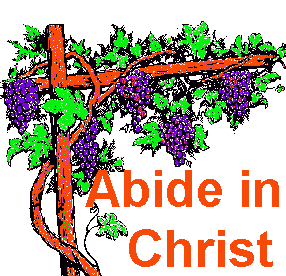Union of
Believers in Christ
by A. A. Hodge
Excerpted from THE
CONFESSION OF FAITH
3 Murrayfield Road,
Edinburgh EH12 6EL
1879 edition
1. To whom are all men
united in their natural estate?
To Adam. Our union with
him includes,
1st,
his federal headship under the covenant of
works.—Rom. 5:12–19.
2nd.
His natural headship, as per force of ordinary
generation, the source of our nature, and of its
moral corruptions.—Gen. 5:3; 1 Cor. 15:49.
But the law upon which
rested the covenant of works, whereby we were held
in union with Adam, having been slain by Christ,
"that being dead wherein we were held," we were
"married to another," that is, to Christ.—Rom.
7:1–4.
2. What is the general
nature of our union with Christ?
It is a single, ineffable
and most intimate union, presenting to our view two
different aspects, and giving rise to two different
classes of consequents.
1st.
The first aspect of this union is its federal and
representative character, whereby Christ, as the
second Adam (1 Cor. 15:22), assumes in the
covenant of grace those broken obligations of the
covenant of works which the first Adam failed to
discharge, and fulfills them all in behalf of all
his "sheep,""they whom the Father has given
him." The consequences which arise from our union
with Christ under this aspect of it are such as the
imputation of our sins to him, and of his
righteousness to us, and all of the forensic
benefits of justification and adoption, etc.—See
Chaps. 33., 34.
2nd.
The second aspect of this union is its spiritual and
vital character, the nature and consequences of
which it is our business to discuss under the
present head.
3. What is the
foundation of this union?
(1.)
The eternal purpose of the triune God, expressed in
the decree of election (we were chosen in him before
the foundation of the world.—Eph. 1:4), providing
for its own fulfillment in the covenant of grace
between the Father as God absolute, and the Son as
Mediator.—John 17:2–6; Gal. 2:20;
(2.)
in the incarnation of the Son, whereby he assumed
fellowship with us in community of nature, and
became our brother.—Heb. 2:16, 17; and
(3.)
in the mission and official work of the Spirit of
Christ (1 John 4:13), through the powerful
operation of whom in the bodies and souls of his
people the last Adam is made a quickening spirit (1
Cor. 15:45), and they are all constituted the body
of Christ and members in particular. 1 Cor. 12:27.
4. By what analogies
drawn from earthly relations is this union of
believers with Christ illustrated in Scripture?
The technical designation
of this union in theological language is
"mystical," because it so far transcends all the
analogies of earthly relationships, in the intimacy
of its communion, in the transforming power of its
influence, and in the excellence of its
consequences. Yet Holy Scripture illustrates
different aspects of this fountain of graces by many
apt though partial analogies.
As,
1st,
foundation of a building and its superstructure.—1
Pet. 2:4, 6.
2nd.
Tree and its branches.—John 15:5.
3rd.
Head and members of the body.—Eph. 4:15, 16.
4th.
Husband and wife.—Eph. 5:31, 32; Rev. 19:7–9.
5th.
Adam and his descendants, ill both their federal and
natural relations.—Rom. 5:12–19; 1 Cor. 15:22,
49.
5. What is the
essential nature of this union?
On the one hand, this
union does not involve any mysterious confusion of
the person of Christ with the persons of his people;
and, on the other hand, it is not such a mere
association of separate persons as exists in human
societies. But it is a union which,
1st,
determines our legal status on the same basis with
his.
2nd.
Which revives and sustains, by the influence of his
indwelling Spirit, our spiritual lift, from the
fountain of his life, and which transforms our
bodies and souls into the likeness of his glorified
humanity.
It is, therefore—
1st.
A spiritual union. Its actuating source and bond is
the spirit of the head, who dwells and works in the
members. 1 Cor. 6:17; 12:13; 1 John 3:24;
4:13.
2nd.
A vital union, i. e., our spiritual life is
sustained and determined in its nature and movement
by the life of Christ, through the indwelling of his
Spirit.—John 14:19; Gal. 2:20.
3rd.
It embraces our entire persons, our bodies through
our spirits.—1 Cor. 6:15, 19.
4th.
It is a legal or federal union, so that all of our
legal or covenant responsibilities rest upon Christ,
and all of his legal or covenant merits accrue to
us.
5th.
It is an indissoluble union.—John 10:28; Rom.
8:35, 37; 1 Thess. 4:14, 17.
6th.
This union is between the believer and the person of
the God–man in his office as Mediator. Its immediate
organ is the Holy Spirit, who dwells in us, and
through him we are virtually united to and commune
with the whole Godhead, since he is the Spirit of
the Father as well as of the Son.—John 14:23;
17:21, 23.
6. How is this union
between Christ and the Christian established?
It was established in the
purpose and decree of God, and in the Covenant of
the Father with the Son from eternity.—Eph. 1:4;
John 17:2, 6. Nevertheless, the elect, as to
personal character and present relations, before
their effectual calling by the Spirit, are born and
continued "by nature children of wrath even as
others," and "strangers to the covenants of
promise."Eph. 2:3, 12. In God’s appointed time,
with each individual of his chosen, this union is
established mutually—
1st.
By the commencement of the effectual and permanent
workings of the Holy spirit within them (they are
quickened together with Christ in the act of the new
birth opening the eyes and renewing the will, and
thus laying in their natures the foundation of the
exercise of saving faith
2nd.
Which faith is the second bond by which this mutual
union is established, by the continued actings of
which their fellowship with Christ is sustained, and
its blessed consequences developed.—Eph. 3:17.
Thus we "come to him,""receive him,""eat of his
flesh and drink of his blood," etc.
7. What are the
consequences of this union to the believer?
1st.
They have a community with him in his covenant
standing, and rights. forensically they are rendered
"complete in him." His righteousness and his
father is theirs. They receive the adoption in him,
and are accepted as to both their persons and
services in the beloved. They are sealed by his Holy
Spirit of promise; in him obtain an inheritance; sit
with him on his throne and behold his glory.—Rom.
8:1; Col. 2:10; Eph. 1:6, 11, 13; Phil.
3:8, 9.
As Mediator, Jesus is
"the Christ," the anointed one, and the believer
is the Christian, or receiver of "the unction."
—Acts 11:26; 1 John 2:20. His mediatorial office
embraces three principal functions—
(1.)
That of prophet, and in fellowship with him the
believer is a prophet.—John 16:13; 1 John 2:27.
(2.)
That of priest, and the believer also is a priest in
him. Isa. 61:6; 1 Pet. 2:5; Rev. 20:6.
(3.)
That of king, and in him the believer is a king.—1
Pet. 2:9; Rev. 3:21; 5:10.
2nd.
They have fellowship with him in the transforming,
assimilating power of his life, making them like
him; every grace of Jesus reproducing itself in
them; "of his fullness we have all received, and
grace for grace." This holds true, (I) with regard
to our souls, Rom. 8:9; Phil. 2:5; 1 John 3:2;
(2) with regard to our bodies, causing them to be
now the temples of the Holy Ghost, 1 Cor. 6:17,
19; and his resurrection to be the cause of ours,
and his glorified body to be the type of ours.—Rom.
6:5; 1 Cor. 15:47, 49; Phil. 3:21. And thus
believers are made to bear fruit in Christ, both in
their bodies and spirits, which are his.—John
15:5; 2 Cor. 12:9; 1 John 1:6.
3rd.
This leads to their fellowship with Christ in their
experience, in their labors, sufferings,
temptations, and death.—Gal. 6:17; Phil. 3:10;
Heb. 12:3; 1 Pet. 4:13. Thus rendering sacred
and glorious even our earthly life.
4th.
Also to Christ’s rightful fellowship with them in
all they possess. Prov. 19:17; Rom. 14:8; 1
Cor. 6:19, 20.
5th.
Also to the consequence that, in the spiritual
reception of the holy sacraments, they do really
hold fellowship with him. They are "baptized into
Christ."—Gal. 3:27. "The bread which we break,
is it not the communion of the body of Christ; the
cup of blessing which we bless, is it not the
communion of the blood of Christ."—1 Cor. 10:16;
11:26; John 6:51–56.
6th.
This leads also to the fellowship of believers with
one another through him, that is, to the communion
of saints.
8. What is the nature
of that "communion of saints" which springs from
the union of each saint with the Lord?
See "Confession of
Faith," Chapter 26. Believers being all united to
one head are, of course, through him mutually,
related in the same community of spirit, life,
status, and covenanted privileges with one another.
This involves upon the
part of all believers—
1st.
Reciprocal obligations and offices according to the
special grace vouchsafed to each. Like the several
organs of the body all have part in the same general
life, yet each has his own individual difference of
qualification, and consequently of duty; "for the
body is not one member but many."—1 Cor. 12:4–21;
Eph. 4:11–13.
2nd.
They have fellowship in each other’s gifts and
complementary graces, each contributing his special
loveliness to the beauty of the whole.—Eph. 4:15,
16.
3rd.
These reciprocal duties have respect to the bodies
and temporal interests of the brethren, as well as
to those which concern the soul.—Gal 2:10; 1 John
3:16–18.
4th.
They have fellowship in faith and doctrine.—Acts
2:42; Gal. 2:9.
5th.
In mutual respect and subordination.—Rom. 12:10;
Eph. 5:21; Heb. 13:17.
6th.
In mutual love and sympathy.—Rom. 12:10; 1 Cor.
12:26.
7th.
This fellowship exists unbroken between believers on
earth and in heaven. There is one "whole family in
heaven and on earth."—Eph. 3:15.
8th.
In glory this communion of saints shall be
perfected, when there is "one fold and one
shepherd," when all saints shall be one as Father
and Son are one.—John 10:16; 17:22.
Index to
Series of
Sermons on Our Vital Union in Christ
Our
Vital Union with Christ: The Application of Christ's
Redemption . . . by A. H. Strong
Series: Vital
Union with Jesus Christ
If you need help in
becoming a Christian here is
a free gift for you.



